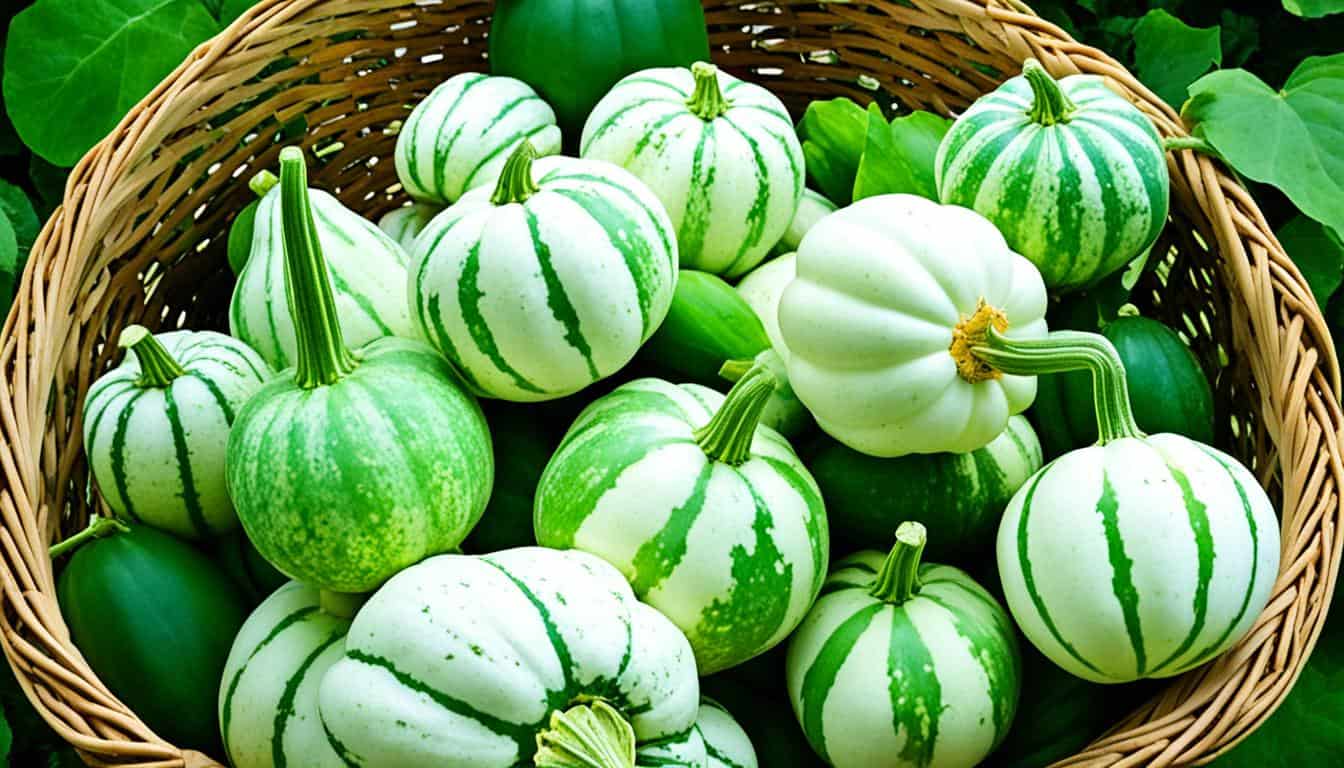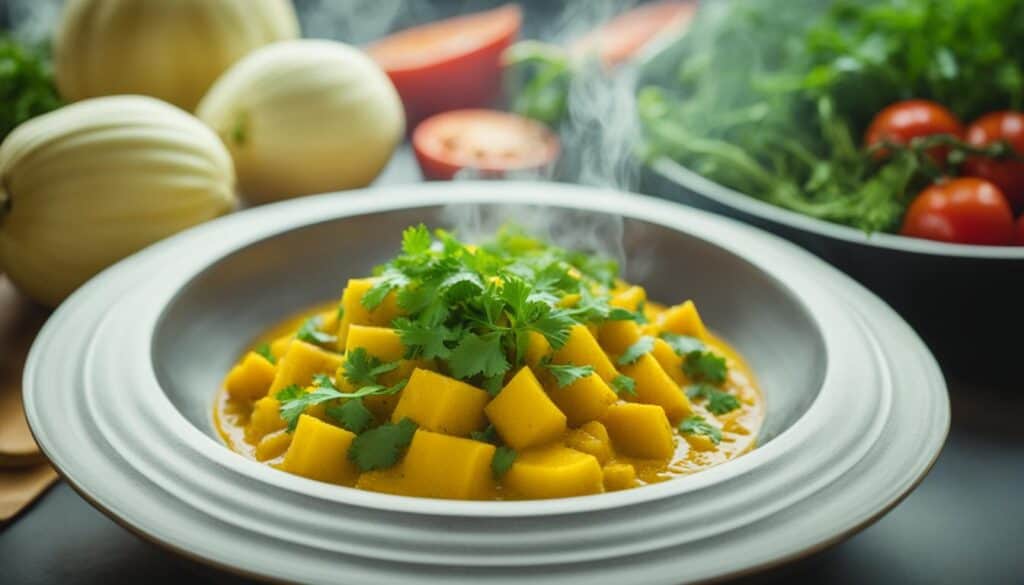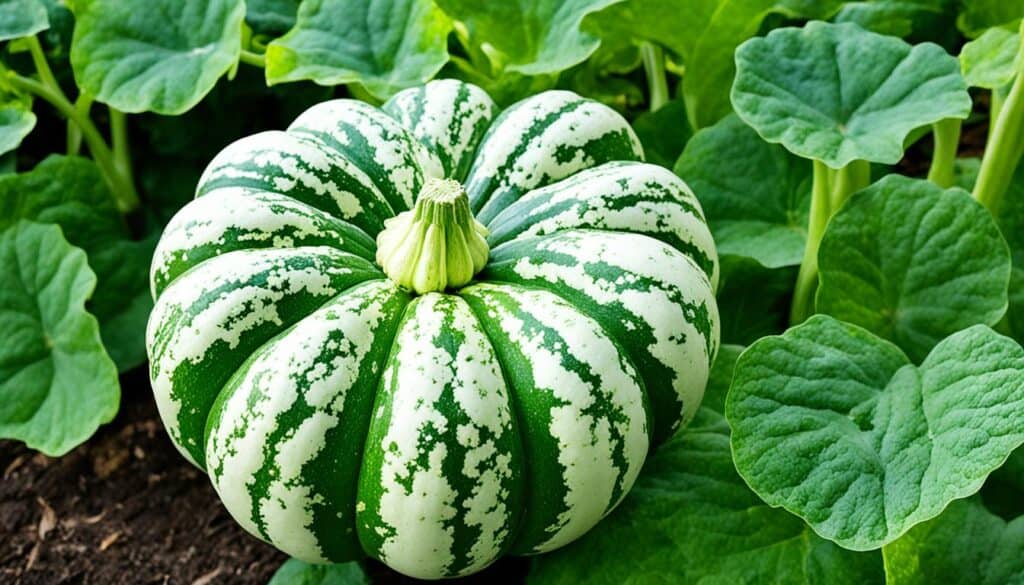Did you know that opo squash, also known as opo vegetable or opo gourd, is a versatile vegetable that can be enjoyed year-round? This unique vegetable offers a mild, grassy taste and is perfect for a variety of culinary preparations. Whether you’re a home gardener looking to grow your own produce or a food enthusiast searching for new flavors, opo squash is sure to impress with its versatility and nutritional benefits.
Key Takeaways:
- Opo squash is a versatile vegetable with a mild, grassy taste.
- It is available year-round, with a peak season in the summer through early fall.
- Opo squash is a source of vitamin C, calcium, iron, fiber, and potassium.
- It can be eaten raw or cooked and is used in a variety of culinary preparations.
- Growing opo squash in your garden is a rewarding experience.
Description and Taste of Opo Squash
When it comes to describing opo squash, the first thing that comes to mind is its unique shape. This vegetable has an elongated, cylindrical form with blunt, curved ends. Its smooth, taut skin is somewhat tough, and it starts off with a pale green color that turns yellow-green as it ripens. Once you cut open an opo squash, you’ll discover its firm, moist flesh. It’s crisp and succulent, encasing cream-colored to ivory seeds. The taste of opo squash is mild, neutral, and subtly green, with a hint of grassiness.
Opo squash can be enjoyed in various ways, both raw and cooked, making it a versatile culinary ingredient. Its texture adds a delightful element to dishes, making it a favorite among home cooks and chefs alike.
Whether you’re looking to create a refreshing salad, a comforting soup, or a flavorful stir-fry, opo squash can be your go-to ingredient. Its mild taste allows it to complement a wide range of flavors and cuisines.
Seasonality and Availability of Opo Squash
Opo squash, a versatile vegetable, is readily available throughout the year. Its peak season, however, occurs during the summer through early fall. During this time, opo squash is at its freshest and most abundant, making it the ideal time to enjoy its unique flavors and culinary versatility.
Opo squash can be found in various regions, thanks to its widespread cultivation commercially, as well as in home gardens and even in the wild. Its popularity and versatility have made it a readily available ingredient in many markets and grocery stores. Whether you prefer to grow your own or purchase from local suppliers, you can easily find opo squash during its peak season and enjoy it throughout the year.
With its consistent availability, opo squash allows you to experiment with different recipes and explore its culinary uses and potential. From refreshing salads to hearty stews and curries, opo squash adds a unique flavor and texture to a wide range of dishes. Embrace the opo squash season and savor the deliciousness it brings to your meals!
Opo Squash Seasonality and Availability
| Season | Availability |
|---|---|
| Summer through early fall | Peak season |
| Year-round | Readily available |
Health Benefits of Opo Squash
Opo squash is not only a delicious addition to your meals but also a powerhouse of nutrition. This versatile vegetable offers numerous health benefits that can support your overall well-being.
Vitamins and Minerals
Opo squash is packed with essential vitamins and minerals that are vital for maintaining good health. It is a rich source of vitamin C, which boosts your immune system and protects against common illnesses. Additionally, opo squash contains calcium, an essential mineral for strong bones and teeth. Iron is another important nutrient found in opo squash, which is necessary for healthy blood circulation.
Nutrient-Rich and Digestive Friendly
Not only does opo squash provide key vitamins and minerals, but it is also high in fiber, potassium, and magnesium. Fiber aids in digestion, promotes regular bowel movements, and helps to maintain a healthy weight. Potassium is crucial for fluid balance and supporting proper nerve function, while magnesium plays a role in over 300 biochemical reactions in the body.
Anti-inflammatory and Detoxifying
Opo squash contains properties that have anti-inflammatory effects in the body. Consuming this vegetable regularly can help reduce inflammation and potentially prevent chronic diseases. Additionally, opo squash has been used in traditional medicine as a detoxifying agent, promoting better digestion and eliminating toxins from the body.
“Opo squash is a nutritious vegetable that not only tastes great but also provides a wealth of health benefits.”
Overall, incorporating opo squash into your diet can have a positive impact on your health. Its combination of vitamins, minerals, fiber, and other beneficial compounds make it a valuable addition to any balanced meal plan.
The following table provides an overview of the key nutrients found in a 1-cup (160g) serving of cooked opo squash:
| Nutrient | Amount | % Daily Value* |
|---|---|---|
| Vitamin C | 20 mg | 22% |
| Calcium | 35 mg | 3% |
| Iron | 2 mg | 11% |
| Fiber | 4 g | 14% |
| Potassium | 390 mg | 8% |
| Magnesium | 45 mg | 11% |
*% Daily Values are based on a 2,000 calorie diet.
These values may vary slightly depending on the specific variety of opo squash and the cooking method.
Culinary Uses of Opo Squash
Opo squash is not only a versatile ingredient but also a culinary delight. From salads to soups, it can be used in various dishes to add a refreshing and unique flavor. Here are some mouth-watering opo squash recipes, cooking ideas, and dishes that will surely tantalize your taste buds:
-
Opo Squash Salad: Shred opo squash and toss it with a mix of fresh greens, cherry tomatoes, cucumber, and feta cheese. Drizzle with a tangy lemon vinaigrette for a healthy and refreshing salad.
-
Opo Squash Fritters: Grate opo squash and mix it with flour, eggs, onions, and spices. Fry the mixture into crispy fritters, perfect as an appetizer or snack.
-
Opo Squash Curry: Simmer opo squash with coconut milk, curry paste, and aromatic spices for a flavorful and creamy curry. Serve it over steamed rice for a satisfying meal.
-
Opo Squash Stir-Fry: Slice opo squash and stir-fry it with garlic, ginger, and your choice of protein and vegetables. Season with soy sauce and sesame oil for a quick and delicious meal.
-
Opo Squash Stuffed with Ground Meat: Cut opo squash into large sections and hollow them out. Stuff the hollowed sections with a mixture of ground meat, onions, and herbs. Bake until tender and enjoy a hearty and flavorful meal.
These are just a few examples of the culinary possibilities with opo squash. Get creative in the kitchen and experiment with different flavor combinations and cooking techniques. Whether you’re a fan of Mediterranean, Indian, Filipino, Thai, or Chinese cuisine, opo squash has a place in your recipes.
Recipe Idea: Opo Squash Curry
Try this delicious and aromatic Opo Squash Curry recipe:
| Ingredients | Instructions |
|---|---|
|
|
Enjoy the rich flavors of this opo squash curry, and explore the culinary wonders of this versatile vegetable in your own kitchen.
Cultural Significance of Opo Squash
Opo squash carries a deep cultural significance that spans across regions and centuries. With its roots tracing back to Chinese culture, this versatile vegetable has played diverse roles in various traditions and practices.
Known by different names worldwide, opo squash has been an integral part of Chinese society for centuries. In China, it was not only valued for its culinary uses but also had practical and decorative applications.
“Dried opo squashes were ingeniously used as carrying cases for medicines in ancient China, showcasing the vegetable’s versatility beyond the kitchen.”
In addition to its functional uses, opo squashes were grown in decorative molds for various purposes. These intricately molded squashes showcased the creativity and craftsmanship of the Chinese people.
“Opo squashes have also served as cricket cages in China. These unique containers not only added a touch of elegance to cricket keeping but also served as amplifiers for the captivating sounds of these tiny creatures.”
Opo squash’s cultural significance extends beyond China. It has spread to different parts of the world, adapting and thriving in tropical and subtropical climates. Appreciated for both its culinary and medicinal benefits, opo squash continues to be celebrated and enjoyed by people across cultures.
Growing Opo Squash in Your Garden
If you have a garden and a love for fresh, homegrown produce, growing opo squash is a great addition to your gardening endeavors. Opo squash is a fast-growing vine that can thrive in a tropical to subtropical climate with a long, warm growing season. Here are some tips to help you cultivate opo squash in your garden:
- Choose the right location: Select a sunny spot in your garden for planting opo squash. It thrives in full sun and needs at least 6-8 hours of direct sunlight daily.
- Prepare the soil: Opo squash prefers well-draining soil that is rich in organic matter. Amend your soil with compost or well-rotted manure to improve its fertility.
- Plant the seeds: Plant opo squash seeds directly in your garden after the last frost date. Make sure the soil temperature is at least 60°F (15°C) for successful germination.
- Provide support: Opo squash plants are vigorous climbers, so provide them with a trellis, wall, or fence to climb on. This allows the fruits to hang freely from the vines and develop their signature elongated shape.
- Water regularly: Opo squash requires consistent moisture, especially during hot, dry weather. Water your plants deeply and regularly, ensuring the soil remains evenly moist but not waterlogged.
- Fertilize appropriately: Apply a balanced, slow-release fertilizer to your opo squash plants at the time of planting and then every 4-6 weeks throughout the growing season. This will provide them with the necessary nutrients for healthy growth and fruit development.
- Monitor for pests and diseases: Keep an eye out for common garden pests like aphids, squash bugs, and cucumber beetles. Use organic pest control methods or insecticidal soap to manage infestations. Additionally, watch for signs of diseases such as powdery mildew, and promptly treat or remove affected plants to prevent the spread.
- Harvest at the right time: Opo squash is best harvested when young and tender, usually around 6-8 inches in length. The skin should still be pale green and easily pierced with your thumbnail. Use a sharp knife or shears to cut the fruit from the vine, leaving a short stem attached.
By following these gardening tips, you’ll be well on your way to a successful opo squash harvest. Enjoy the process of growing this versatile vegetable, and reap the rewards of fresh, homegrown produce in your kitchen.
Recipe Ideas for Opo Squash
If you’re looking to explore the culinary possibilities of opo squash, you’re in luck! This versatile vegetable can be used in a variety of delicious recipes that will tantalize your taste buds. Whether you’re a fan of soups, curries, or baked goods, there’s a opo squash recipe for everyone.
Tinolang Manok (Opo Squash and Ginger Chicken Soup)
This traditional Filipino dish combines opo squash, chicken, ginger, and other flavorful ingredients to create a hearty and comforting soup. The opo squash adds a subtle sweetness and a delightful texture to the dish.
Opo in a Roasted Eggplant Sauce
This Mediterranean-inspired recipe pairs opo squash with a rich and flavorful roasted eggplant sauce. The combination of smoky eggplant and tender opo squash creates a dish that will satisfy your taste buds.
Eggless Chocolate Bottle Gourd Cake
If you’re a fan of baking, why not try incorporating opo squash into a sweet treat? This eggless chocolate bottle gourd cake is moist, rich, and utterly delicious. The opo squash adds moisture and a subtle sweetness to the cake.
Bottle Gourd Curry
For those craving a taste of Indian cuisine, bottle gourd curry is a must-try. This flavorful curry combines opo squash with aromatic spices, creating a dish that is both comforting and satisfying. Serve it with rice or flatbread for a complete meal.
Doodhi Kofta Curry (Deep Fried Bottle Gourd Meatballs in Gravy)
Inspired by the flavors of North Indian cuisine, this recipe features deep-fried opo squash meatballs simmered in a rich and creamy gravy. The opo squash meatballs are soft, flavorful, and pair perfectly with the fragrant curry.
Bottle Gourd Nippattu
Nippattu is a popular South Indian snack made with a combination of spices, grains, and vegetables. This recipe adds opo squash to the mix, creating a delicious and crispy snack that is perfect for any occasion.
Bottle Gourd Fritters in Onion Tomato Gravy
If you’re in the mood for a flavorful and indulgent dish, try these opo squash fritters in a tangy onion tomato gravy. The crispy fritters absorb the flavors of the rich gravy, creating a mouthwatering combination.
Opo Squash in Tomato Sauce
This simple yet satisfying recipe features opo squash cooked in a savory tomato sauce. The opo squash absorbs the flavors of the tangy tomato sauce, resulting in a delicious and comforting dish.
These recipes showcase the versatility of opo squash and its ability to enhance the flavors of different cuisines. Whether you’re a fan of soups, curries, or baked goods, opo squash can be a delicious addition to your culinary repertoire. So why not get creative in the kitchen and try out some opo squash recipes today?
Round Opo Squash: A Variation Worth Trying
If you’re looking to add a unique twist to your culinary creations, round opo squash is a variation of opo squash that is definitely worth exploring. While it shares many similarities with its elongated counterpart, round opo squash offers a slightly different shape and texture that can add visual appeal to your dishes.
Round opo squash has an oval to round appearance, distinguishing it from the traditional elongated opo varieties. Its skin is smooth and firm, just like the regular opo squash, but the shape adds a delightful touch of variety to your recipes.
In terms of taste, round opo squash maintains the mild and pleasant flavor that is characteristic of opo squash. It boasts a slightly less tender texture compared to the elongated variety, but it is still versatile and can be used in similar culinary preparations.
If you’re looking to expand your culinary horizons, round opo squash adds an exciting twist to your dishes. Its unique shape and mild flavor make it a great addition to stir-fries, soups, and curries.
Round opo squash is available year-round, with its peak season occurring in the summer through early fall. This means you can enjoy its culinary delights throughout the year, incorporating it into various recipes to enhance the flavors and presentation of your dishes.
Here’s a simple comparison between round opo squash and traditional opo squash:
| Characteristics | Round Opo Squash | Regular Opo Squash |
|---|---|---|
| Shape | Oval to Round | Elongated and Cylindrical |
| Texture | Slightly less tender | Tender |
| Taste | Mild and Pleasant | Mild and Pleasant |
| Availability | Year-round with peak season in summer through early fall | Year-round with peak season in summer through early fall |
As you can see from the comparison above, round opo squash offers a unique shape and slightly different texture, while still maintaining the mild and pleasant taste that opo squash is known for. Its availability year-round ensures that you can experiment with this variation whenever you feel inspired in the kitchen.
So, if you’re ready to explore new flavors and add an artistic touch to your recipes, give round opo squash a try. Unlock the culinary potential of this delightful variation and let it elevate your dishes to a whole new level of visual and gastronomic enjoyment.
Conclusion
As we conclude our exploration of opo squash, it’s clear that this versatile vegetable is a delightful addition to any garden and kitchen. With its mild, grassy taste and elongated shape, opo squash lends itself to a variety of culinary preparations. Whether raw or cooked, it offers a unique flavor profile that can enhance a range of dishes.
Beyond its culinary uses, opo squash also boasts numerous health benefits. Packed with essential nutrients like vitamin C, calcium, and iron, it supports immune function, bone health, and blood circulation. Additionally, its high fiber content aids in digestion and promotes satiety. With opo squash, you can indulge in delicious recipes while nourishing your body.
This remarkable vegetable also holds cultural significance. It has a rich history that spans different regions, and its unique characteristics have made it a staple in various cuisines around the world. By embracing opo squash, you can not only enjoy its flavors but also connect with culinary traditions that have stood the test of time.
Whether you’re already growing opo squash in your garden or are inspired to give it a try, remember that this vegetable offers a world of possibilities in the kitchen. So, go ahead and explore the wonders of opo squash – elevate your meals and savor the goodness this remarkable vegetable has to offer.










Leave a Reply